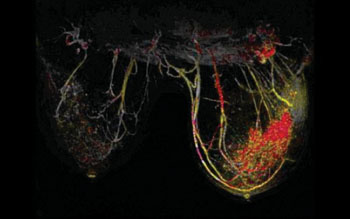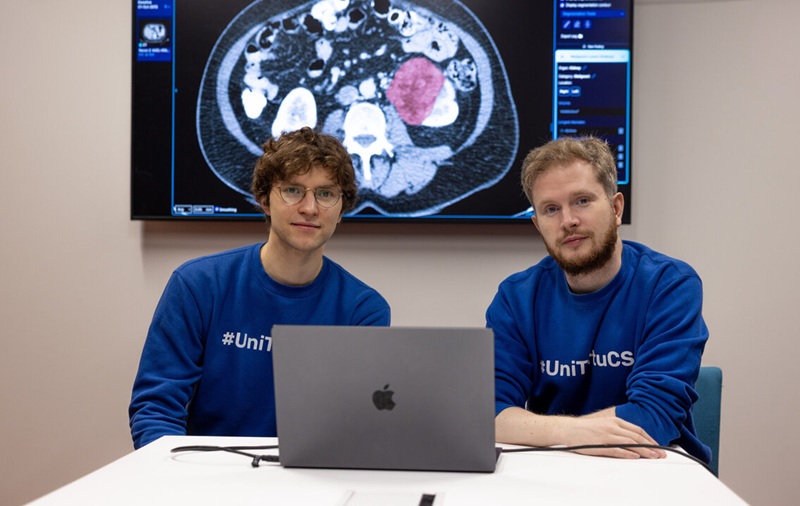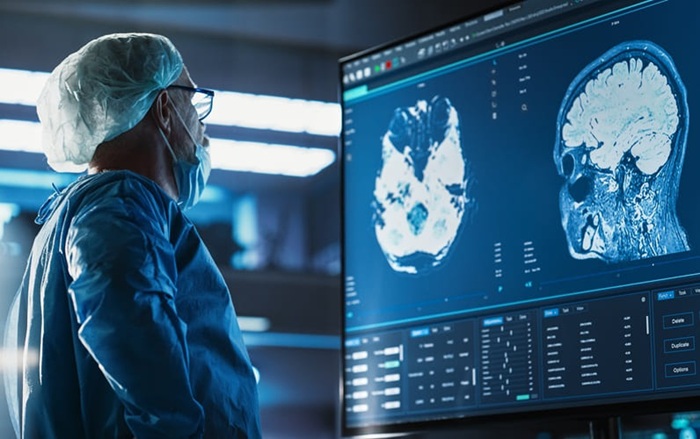Diffusion-Weighted MRI Technique Cuts Breast Biopsy Requirements
|
By MedImaging International staff writers Posted on 18 Oct 2015 |

Image: A diagnostic DWIBS MRI mammography demonstrating a lesion (Photo courtesy of DKFZ).
An abbreviated magnetic resonance imaging (MRI) protocol could reduce unnecessary breast biopsies by providing additional information on suspicious X-ray screening mammography findings, according to a new study.
Researchers at the German Cancer Research Center (DKFZ; Heidelberg, Germany), University Hospital Heidelberg (Germany), and other institutions conducted a study to evaluate the ability of an abbreviated MRI protocol consisting of maximum intensity projections (MIPs) from diffusion-weighted imaging with background suppression (DWIBS) and unenhanced morphologic sequences to help predict the likelihood of malignancy on suspicious screening X-ray mammograms, as compared with an abbreviated contrast material-enhanced MRI protocol and a full diagnostic breast MRI protocol.
To do so, 50 women (mean age 57.1 years), who gave informed consent and who had suspicious screening mammograms and an indication for biopsy participated in a prospective study from September 2014 to January 2015. Before biopsy, a full diagnostic contrast-enhanced MRI was performed that included DWIBS. Two abbreviated protocols based on MIPs were evaluated; the first showed the shape and appearance of the lesion; the second displayed its biophysiological properties with DWIBS, a technique that works by assessing the diffusion of water molecules through tissue, since areas of restricted diffusion may indicate malignancy.
The results showed that 25 of the 50 participants had a breast carcinoma. DWIBS achieved a comparable accuracy to that of the full diagnostic and the abbreviated contrast-enhanced MRI protocols, yielding an excellent negative predictive value of 92%. Only pure microcalcification related ductal carcinoma in-situ (DCIS) without solid tumor—a very early stage of breast cancer—was not detected by any of the MRI techniques. The study was published early online on September 11, 2015, in Radiology.
“If the preliminary findings are confirmed, this approach could have a high potential to be used as an adjunct in the clarification process of unclear lesions on X-ray mammography in breast cancer screening,” said lead author Sebastian Bickelhaupt, MD, a radiologist at DKFZ. “This might help to reduce the number of invasive biopsies and the related anxiety in women who have suspicious findings at mammography.”
DWIBS MRI holds several advantages; the images can be obtained in less than seven minutes, compared with more than 30 minutes for a full breast MRI protocol; and the mean reading time using the unenhanced DWIBS method is less than 30 seconds thanks to MIPS, a technique that allows lesion assessment by reading one summation image instead of multiple single-slice images. The technique however, is in its early stages, and as such is not intended as a standalone screening modality but as an adjunct to X-ray mammography and tomosynthesis.
Related Links:
German Cancer Research Center
University Hospital Heidelberg
Researchers at the German Cancer Research Center (DKFZ; Heidelberg, Germany), University Hospital Heidelberg (Germany), and other institutions conducted a study to evaluate the ability of an abbreviated MRI protocol consisting of maximum intensity projections (MIPs) from diffusion-weighted imaging with background suppression (DWIBS) and unenhanced morphologic sequences to help predict the likelihood of malignancy on suspicious screening X-ray mammograms, as compared with an abbreviated contrast material-enhanced MRI protocol and a full diagnostic breast MRI protocol.
To do so, 50 women (mean age 57.1 years), who gave informed consent and who had suspicious screening mammograms and an indication for biopsy participated in a prospective study from September 2014 to January 2015. Before biopsy, a full diagnostic contrast-enhanced MRI was performed that included DWIBS. Two abbreviated protocols based on MIPs were evaluated; the first showed the shape and appearance of the lesion; the second displayed its biophysiological properties with DWIBS, a technique that works by assessing the diffusion of water molecules through tissue, since areas of restricted diffusion may indicate malignancy.
The results showed that 25 of the 50 participants had a breast carcinoma. DWIBS achieved a comparable accuracy to that of the full diagnostic and the abbreviated contrast-enhanced MRI protocols, yielding an excellent negative predictive value of 92%. Only pure microcalcification related ductal carcinoma in-situ (DCIS) without solid tumor—a very early stage of breast cancer—was not detected by any of the MRI techniques. The study was published early online on September 11, 2015, in Radiology.
“If the preliminary findings are confirmed, this approach could have a high potential to be used as an adjunct in the clarification process of unclear lesions on X-ray mammography in breast cancer screening,” said lead author Sebastian Bickelhaupt, MD, a radiologist at DKFZ. “This might help to reduce the number of invasive biopsies and the related anxiety in women who have suspicious findings at mammography.”
DWIBS MRI holds several advantages; the images can be obtained in less than seven minutes, compared with more than 30 minutes for a full breast MRI protocol; and the mean reading time using the unenhanced DWIBS method is less than 30 seconds thanks to MIPS, a technique that allows lesion assessment by reading one summation image instead of multiple single-slice images. The technique however, is in its early stages, and as such is not intended as a standalone screening modality but as an adjunct to X-ray mammography and tomosynthesis.
Related Links:
German Cancer Research Center
University Hospital Heidelberg
Latest MRI News
- Novel Imaging Approach to Improve Treatment for Spinal Cord Injuries
- AI-Assisted Model Enhances MRI Heart Scans
- AI Model Outperforms Doctors at Identifying Patients Most At-Risk of Cardiac Arrest
- New MRI Technique Reveals Hidden Heart Issues
- Shorter MRI Exam Effectively Detects Cancer in Dense Breasts
- MRI to Replace Painful Spinal Tap for Faster MS Diagnosis
- MRI Scans Can Identify Cardiovascular Disease Ten Years in Advance
- Simple Brain Scan Diagnoses Parkinson's Disease Years Before It Becomes Untreatable
- Cutting-Edge MRI Technology to Revolutionize Diagnosis of Common Heart Problem
- New MRI Technique Reveals True Heart Age to Prevent Attacks and Strokes
- AI Tool Predicts Relapse of Pediatric Brain Cancer from Brain MRI Scans
- AI Tool Tracks Effectiveness of Multiple Sclerosis Treatments Using Brain MRI Scans
- Ultra-Powerful MRI Scans Enable Life-Changing Surgery in Treatment-Resistant Epileptic Patients
- AI-Powered MRI Technology Improves Parkinson’s Diagnoses
- Biparametric MRI Combined with AI Enhances Detection of Clinically Significant Prostate Cancer
- First-Of-Its-Kind AI-Driven Brain Imaging Platform to Better Guide Stroke Treatment Options
Channels
Radiography
view channel
AI Detects Early Signs of Aging from Chest X-Rays
Chronological age does not always reflect how fast the body is truly aging, and current biological age tests often rely on DNA-based markers that may miss early organ-level decline. Detecting subtle, age-related... Read more
X-Ray Breakthrough Captures Three Image-Contrast Types in Single Shot
Detecting early-stage cancer or subtle changes deep inside tissues has long challenged conventional X-ray systems, which rely only on how structures absorb radiation. This limitation keeps many microstructural... Read moreUltrasound
view channel
Wearable Ultrasound Imaging System to Enable Real-Time Disease Monitoring
Chronic conditions such as hypertension and heart failure require close monitoring, yet today’s ultrasound imaging is largely confined to hospitals and short, episodic scans. This reactive model limits... Read more
Ultrasound Technique Visualizes Deep Blood Vessels in 3D Without Contrast Agents
Producing clear 3D images of deep blood vessels has long been difficult without relying on contrast agents, CT scans, or MRI. Standard ultrasound typically provides only 2D cross-sections, limiting clinicians’... Read moreNuclear Medicine
view channel
PET Imaging of Inflammation Predicts Recovery and Guides Therapy After Heart Attack
Acute myocardial infarction can trigger lasting heart damage, yet clinicians still lack reliable tools to identify which patients will regain function and which may develop heart failure.... Read more
Radiotheranostic Approach Detects, Kills and Reprograms Aggressive Cancers
Aggressive cancers such as osteosarcoma and glioblastoma often resist standard therapies, thrive in hostile tumor environments, and recur despite surgery, radiation, or chemotherapy. These tumors also... Read more
New Imaging Solution Improves Survival for Patients with Recurring Prostate Cancer
Detecting recurrent prostate cancer remains one of the most difficult challenges in oncology, as standard imaging methods such as bone scans and CT scans often fail to accurately locate small or early-stage tumors.... Read moreGeneral/Advanced Imaging
view channel
AI-Based Tool Accelerates Detection of Kidney Cancer
Diagnosing kidney cancer depends on computed tomography scans, often using contrast agents to reveal abnormalities in kidney structure. Tumors are not always searched for deliberately, as many scans are... Read more
New Algorithm Dramatically Speeds Up Stroke Detection Scans
When patients arrive at emergency rooms with stroke symptoms, clinicians must rapidly determine whether the cause is a blood clot or a brain bleed, as treatment decisions depend on this distinction.... Read moreImaging IT
view channel
New Google Cloud Medical Imaging Suite Makes Imaging Healthcare Data More Accessible
Medical imaging is a critical tool used to diagnose patients, and there are billions of medical images scanned globally each year. Imaging data accounts for about 90% of all healthcare data1 and, until... Read more
Global AI in Medical Diagnostics Market to Be Driven by Demand for Image Recognition in Radiology
The global artificial intelligence (AI) in medical diagnostics market is expanding with early disease detection being one of its key applications and image recognition becoming a compelling consumer proposition... Read moreIndustry News
view channel
GE HealthCare and NVIDIA Collaboration to Reimagine Diagnostic Imaging
GE HealthCare (Chicago, IL, USA) has entered into a collaboration with NVIDIA (Santa Clara, CA, USA), expanding the existing relationship between the two companies to focus on pioneering innovation in... Read more
Patient-Specific 3D-Printed Phantoms Transform CT Imaging
New research has highlighted how anatomically precise, patient-specific 3D-printed phantoms are proving to be scalable, cost-effective, and efficient tools in the development of new CT scan algorithms... Read more
Siemens and Sectra Collaborate on Enhancing Radiology Workflows
Siemens Healthineers (Forchheim, Germany) and Sectra (Linköping, Sweden) have entered into a collaboration aimed at enhancing radiologists' diagnostic capabilities and, in turn, improving patient care... Read more






 Guided Devices.jpg)













